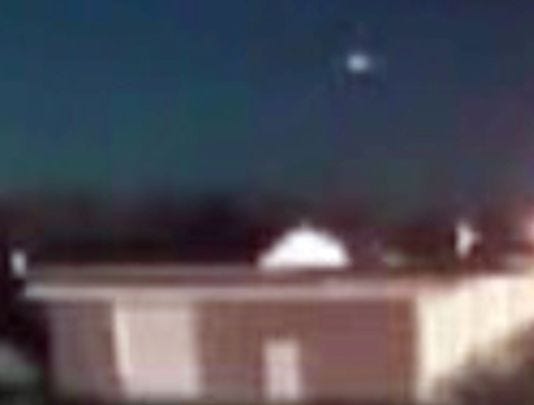Meteor sightings reported from Florida to Massachusetts
A possible meteor has been spotted streaking through the sky over the East Coast, The American Meteor Society and Twitter users are reporting.
 "It basically looked like a super bright shooting star," said Robert Lunsford, fireball coordinator for the society, based on the reports coming in to the organization's website. "I saw some people mentioning fragments and naturally every color of the rainbow."
"It basically looked like a super bright shooting star," said Robert Lunsford, fireball coordinator for the society, based on the reports coming in to the organization's website. "I saw some people mentioning fragments and naturally every color of the rainbow."
The society, based in Geneseo, N.Y., was researching about 400 reports received as of about 10 p.m. ET Friday from nine East Coast States and Canada of sightings that took place somewhere shortly before 8 p.m. ET through shortly after 8 p.m. ET, Lunsford said. The number of reports marked a possible record over the number of reports the group received about a fireball that streaked over Baltimore on Halloween several years ago, Lunsford said.
Late Friday, Bill Cooke of NASA's Meteoroid Environmental Office said the flash appears to be "a single meteor event." He said it "looks to be a fireball that moved roughly toward the southeast, going on visual reports."
"Judging from the brightness, we're dealing with something as bright as the full moon," Cooke said. "The thing is probably a yard across. We basically have (had) a boulder enter the atmosphere over the northeast."
Twitter exploded Friday evening with reports of meteor sightings from the South to New England.
Some Twitter users also reported that the meteor crashed somewhere near the Delaware-Maryland border, but the society had no information on that, Lunsford said.
AccuWeather.com (@breakingweather) tweeted that there have been several unconfirmed reports of a large meteor being spotted from Florida to Massachusetts between 7:55 p.m. and 8:03 p.m. ET.
Reports of a fireball that streaked over the Albany, N.Y., area shortly before 8 p.m. headed south or southeast was reported by Examiner.com.
The fireball was green and had a "fairly long tail," the Examiner reported, adding that it lasted for a few seconds.
Lunsford of the American Meteor Society said it is more common for meteors to cross the sky in the evening this time of year because a certain area of the sky known as a radiant is at its highest point above the horizon during February, March and April.
"We have reports going back to 2005, and the months of February, March and April have a lot of evening fireballs," he said. USAToday
